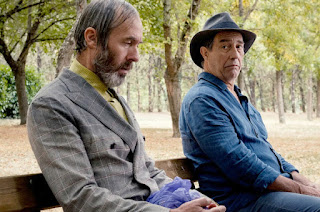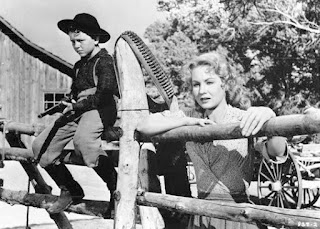Directed by William Castle; produced by Frank King and Maurice King
Millie Baxter (Kim Hunter) arrives in New York to meet Paul (Dean Jagger), her husband of a few weeks. As more than one person remarks, it was as if Millie had married a stranger, as she had met Paul only thrice before agreeing to become his wife. At first it seems as if Paul is deliberately avoiding her; afterward, it’s as if he’s deliberately avoiding everyone else. As suspicions crowd her mind, Millie determines to find out the truth about her new husband, helped by her hometown friend, Fred (Robert Mitchum).
Though the title makes the film sound like a guide-book for newlyweds, and the poster resembles something from a 1950s teenage sex-education pamphlet, When Strangers Marry is a well-made if slight thriller, maximising the best of its assets. It is a production of Momogram Pictures, the most famous company on Hollywood’s metaphoric ‘Poverty Row’. The small budget is clear here, but so are the results: it’s what can be done with few resources.
Interestingly, top-billing went to Jagger upon the film’s release, with ‘Bob Mitchum’ in third place, after Hunter. When the film was re-released in 1949 (re-entitled Betrayed, a more generic and less provocative title than the original), Jagger and Mitchum’s positions were reversed, and Mitchum’s given name became the more familiar ‘Robert’. In terms of screen-time and significance to the movie, the two male stars are about equal.
Though both men give fine performances, these are surpassed by Hunter’s. Her excellent acting anchors the story and her expressions are lively, realistic and telling. Her character experiences the most growth, as well, as Millie struggles to come to terms with the mystery in which she finds herself.
The story rests a bit complacently on coincidence, though the coincidence is a minor one, and is overcome by other elements. The script does a good job of infusing Millie’s initial period in New York, when she is bewildered and alone, with an air of surrealism: callers on the telephone whom she can’t hear, blazing neon lights, raucous music from somewhere, notes slipped through door-cracks.
The direction also rises to the challenge. Castle later went into horror films, some of which are truly bad; in When Strangers Marry, he contributes to the nascent genre of film noir, and deserves credit for his work. There is a nightmarish feel to much of what Millie goes through - perhaps foreshadowing Castle’s later movies - that is effective. (That’s Castle in the photograph the police are given.)
The film includes touches that are as memorable as more significant moments - the annoyed bar-tender handing out glasses of water to customers who want “nothing”, the menacing police detective who obtains information by repeatedly pointing out that a witness’s “life may depend on it”. And who knew there were small businesses in the ‘40s that provided cheap trips to places in private cars? These suggest more than the average amount of thought was spent on the film.
While not a classic of its type, When Strangers Marry is a nifty little thriller that puts a lot into its 67 minutes.
































